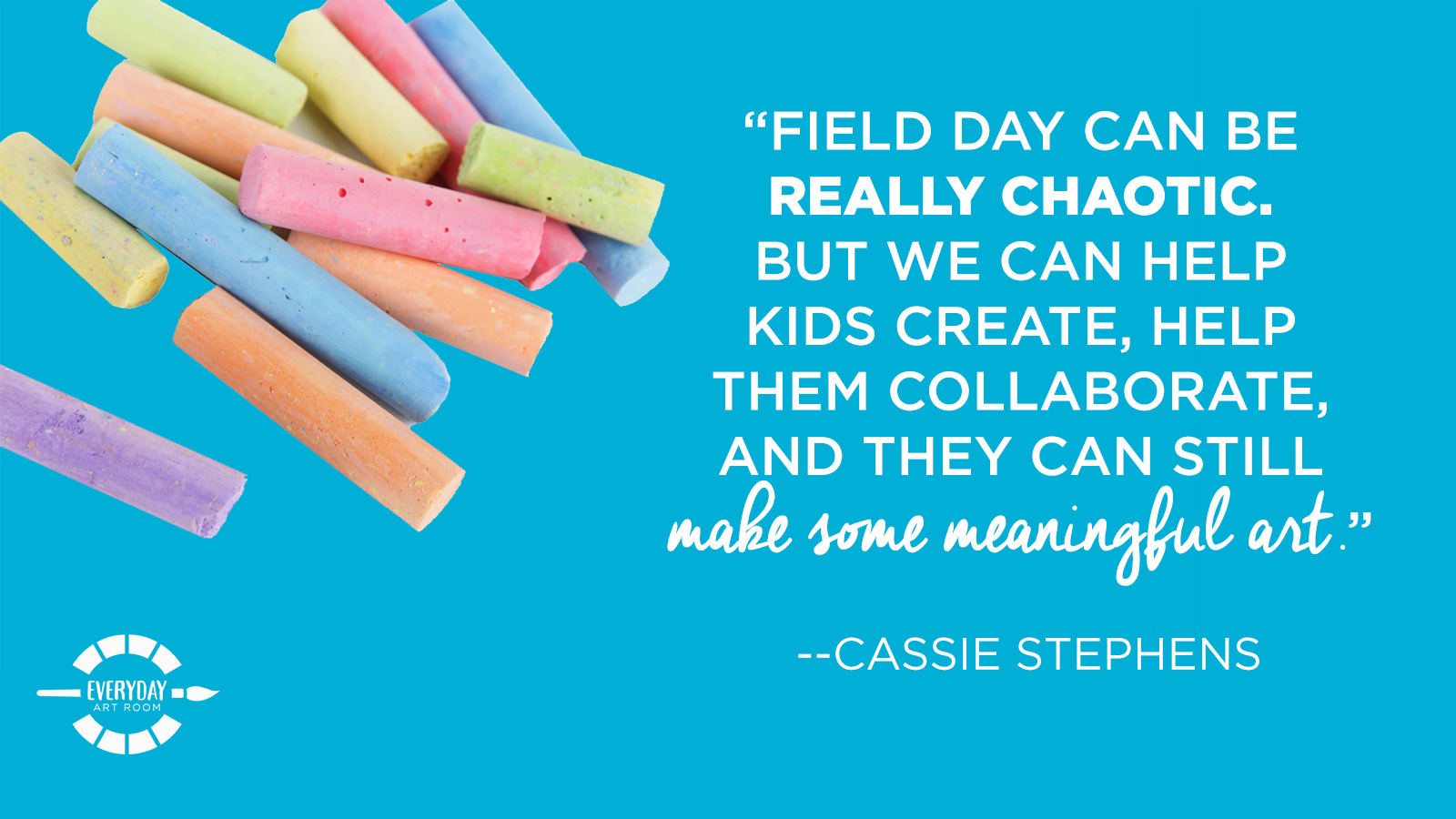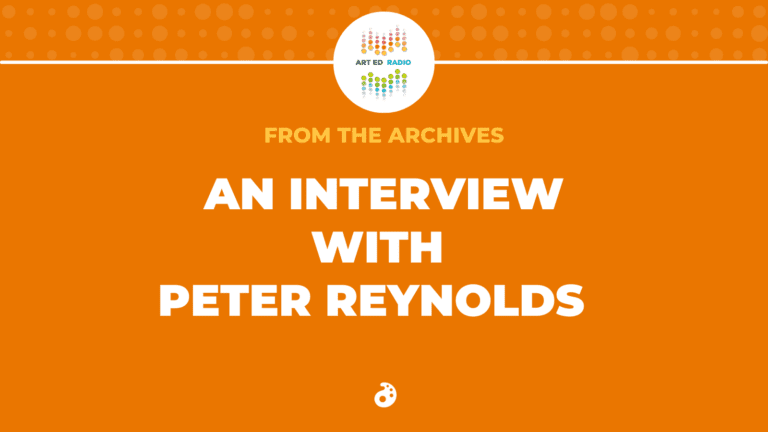From painting hundreds of faces to sidewalk chalk to snow cones (and the resulting ants), Cassie has some stories about her field day experiences. But there are better ways to do meaningful work on those sometimes chaotic field days! Listen as Cassie discusses her collaborative activities, painting stations, and other ideas you can take to your field day this year! Full episode transcript below.
Resources and Links
- Field Day Activites for the Art Room
- 5 Games to Put an Artistic Twist on Field Day
- Why Saying No is the Best Answer Yet

Transcript
Cassie: My first year teaching, seems like every other podcast starts this way, I remember the P.E. teacher came to me and said, “Hey, we are doing a field day, and you are in charge of face painting,” not, “Do you mind,” “Do you want to.” This is a thing I notice that happens to a lot of first-year teachers. It’s kind of a way of hoodwinking us first-year teachers because they assume we don’t know no better and we usually don’t even know that saying no is an option. Side note: It’s totally an option, so new teachers out there, keep that in mind, especially when a P.E. teacher approaches you and says that you are in charge of face painting small humans all day long on field day.
Now, I know, some of you are thinking, “Come on, Cassie. That doesn’t sound that bad.” You all, in 1998, I’d never painted a single face in my life, and so I think it probably took me a good seven minutes to finish painting just one face, only to realize that, oh, no, I was actually in charge of the whole class. Did everybody get a heart slapped on the side of their face? You betcha, and boy, were there some boys who are not too thrilled with me.
Following year, since I dropped the ball on face painting, I was left in charge of the snow cone machine. Guys, they put the snow cone machine in my art room for, I would say the next week, maybe even two, probably until the end of the school year. I had a fine stream of ants in my room just coming in to get that sticky syrup that seemed to be permanently embedded in my floor since, yeah, they put the snow cone machine in the art room. It, like outside was literally just a door away. Why couldn’t it have been there? Another thing I should’ve said no to.
Well, now that I’m much older and wiser, I’ve come up with some ways to do field day that work to, ahem, my benefit and actually make my day go by so fast it’s so fun, and I don’t have to paint a single face or have to battle a stream of ants. Thank you for that.
I thought I would share with you today how I do field day in my room, and I don’t plan on ever going back. It might even convince you to say no to face painting, to snow cones, to sidewalk chalk, which I’ve also gotten stuck with, and try something new. I’m Cassie Stephens, and this is Everyday Art Room.
I don’t even remember a field day when I was a kid. I mean, I just remember we had recess. We played outside, and teachers, I don’t even know if they were around. I just remember that we had a merry-go-round that a lot of kids flew off of, which is probably why they eventually removed it, but it was the ’80s, so it was every man for himself. The teachers were probably inside the lounge smoking. Who knows.
But that being said, when the whole field day concept was thrown my way my first couple of years teaching, I had no clue what it was going to be like. When I moved schools, they also had a field day, I guess it’s pretty common, and I wasn’t really placed in charge of anything except maybe crowd control and making sure the kids had enough water. It wasn’t until we revamped it that they decided that they were going to run field day a little bit differently.
Now, every school is totally different, so I’m going to share with you really quick how my field day at my school is run. That way you’ll have a better understanding of how you can make what I’m about to share with you work in your situation because it may be run the same way, but it may be totally different. Regardless, we’re going to make it so that you don’t have to paint faces, be in charge of sidewalk chalking, and what was the other thing? Oh, yes, snow cone duty. I mean, if you like that kind of thing, go for it.
At my school, field day is an all day long event. Right. Can you imagine? The teachers stay with their students pretty much all day. I’m at a K-4 school. There’s four classes per grade level. I’m at a small school. Every 15 minutes, the students rotate to a new station. When they come to me, my room has an outdoor access door, they come in through that door.
Last year, I was supposed to do my second year of sidewalk chalk. Now, I know, sidewalk chalk is great, but on field day, my lovely, delightful children are usually no longer lovely and delightful because they’ve been outside in that hot Tennessee sun all stinking day. They don’t want to sit next to a steamy sidewalk with a bunch of worn-down chalk and draw a picture because you know what they want to do? They just want to write naughty words like “fart” all over the place and call it done in a couple of minutes and come up to me and say, “Is this all we’re doing?” Yes, it is.
It was the longest day ever, so last year, when they were predicting rain, I was kind of glad because it meant that I had to come up with something that didn’t involve being outside on a sidewalk with a bunch of not-too-thrilled children. Last year, I came up with an idea, and I’ve since expanded it, and now I’m loving field day. Here is what I do.
I do a school-wide collaborative. I feel like field day is the perfect time to do a school-wide collaborative, at least if your field day is set up like mine in that you see everybody, all the kids. I mean, there’s… If I were going to do a collaborative where we’re going to see everybody and have all of my students contribute, it would be a week-long thing. This is a one-and-done type deal, and I love it. Let me share with you why I think it’s the best thing ever.
It’s the end of the school year. It allows me to use up a lot of the supplies. In this case, it was paint. It also makes it so we are creating something really beautiful that can be hung at the beginning of the school year. If you’re like me, the beginning of the school year, it’s exciting to go back to school, but I always feel badly because the halls are so barren, and it looks so institutional. Last year, I decided to have the kids create artwork at the end of the year that could be hung at the beginning of the new school year. This became the kind of… This is where the idea for doing this collaborative kind of all started from.
Let me just share with you how I set up for this field day. Like I said, it takes place in my art room, and I do have the luxury of having that door where the kids can walk from outside directly in to my room. If you don’t have that kind of setup, find the nearest outdoor access where the kids will be and have them route your field day crowd towards you that way.
Now, I’m sure your field day is like mine as well in that there’s a lot of water activities, the kids are sweaty, wet, dirty. That’s just how it’s going to be. All my kids prior to coming in my room were at a water limbo station. They came in squeaking. They came in soaking wet. Whatever. It’s field day. You gotta let some stuff go.
As soon as they walked in my room, the first thing they noticed was that there were absolutely no chairs. They’re only in my room for 15 minutes, and a lot of that time, well, a little bit of that time is spent with me chatting on the front end and them cleaning up on the tail end. No need for chairs.
I did move my tables around quite a bit to set up for what I called stations. These were painting stations, and I’ll get more into that in just a moment, but I will say that since we were painting and each station was painting, I only had to set up paint supplies, brushes, baby wipes for cleaning paint brushes, and paint trays. I totally had my room cleared out anyway because of the art show that had taken place the week before, so my room was pretty bare-looking with just the tables, no chairs, and just the activities on the tables.
Here is something I did this year that really helped. At every table where there was a different kind of painting activity, I had a Dollar Tree stand, like a little, I guess it was a picture frame, a plastic picture frame. In that plastic picture frame stand, I slid a piece of paper that-
I slid a piece of paper that had written on it the amount of kids who could go to that table. So for example, at one painting table, I wrote two artists. At another painting table, which was a lot bigger, I wrote that there could be four artists there. When the kids came in and sat down, I shared with them the three different painting activities that they could go to that day. And like I said, I’ll get more into those in just a moment.
What I told them was, is that once they had to turn around and look really carefully at each one of those painting stations and think really hard about which one sounded the most interesting to them, because once they gathered their paintbrush and their baby wipe for cleaning their brush and they picked their spot, that was where they were going to stay, because on field day they get a little kooky, and they forget that they’re in school, and we still have these things called rules.
Now granted, I let a lot of those rules go flying out the window, but we still have to maintain some sort of, I don’t know, sanity within the walls of the art room. So I tell them that once they pick a spot, that is where they have to stay for the next 12 minutes that they are in my room. I just don’t want them walking around with a paintbrush, bouncing from spot to spot. You pick a spot. You stay in the spot.
Now let’s talk about what the kids were creating. After we walked in, they sat down on the floor. We chatted for a moment. I dismiss them by row to go grab a brush and go grab a baby wipe. Typically when my kids are painting, we use dog dishes filled with water on one side, and a sponge on the other side for washing and drying the brush.
What I noticed when I did this last year was, is that I was constantly changing the water dishes out. I was still constantly washing brushes. Colors were getting a little bit muddy, because the kids in their excitement weren’t being as careful as they normally are.
As much as I hate the idea of the waste of baby wipes, it really did help us tremendously to use those, instead of water cups, to pinch… I call it pinch and pull. Pinch the bristles. Squeeze the paint out. Pull the paintbrush out, getting it as clean as you can. They were limited to one baby wipe, and we talked about how they needed to clean the brush off on their messy mat, by sweeping it back and forth first, before pinching and pulling. The reason being, I didn’t want their baby wipes to be just so filled with paint. So that was kind of what they had to grab, a paint and a baby wipe at that little area that I call the store, where my kids grab supplies, cafeteria style.
So these are the three areas that I had set up for them to go and create. Easily, the most popular, both when I’ve shared it on social media and with my students, were the huge Welcome Back to School banners. How I made these was, I got white bulletin board paper from our work room. I pulled it and made those sheets. Gosh, they were the length of two of my tables, so about 12 feet long. I made four 12 foot long banners. With my ink-filled Bingo dobber, I drew out the words, Welcome back. We missed you. Hello friends. We’re so glad you’re here.
I wrote those letters out in great big block letters, with my Bingo dobber, on that 12 foot piece of paper. Around the letters I drew just a variety of kind of doodley things, pizza, ice cream, clouds, rainbows, anything that I could think of, our school mascot. I drew it fast and furious on those 12 foot banners. I made four, because two are going to be for my morning crew of kids. Two were for the afternoon.
On those tables, after I laid out those huge sheets, I put that sign, that said that four artists could work at one sheet at a time, but I had two tables set up. So technically, eight artists could work. On the tables, I placed ice cube trays. When I set up paint for something like this, especially since my students were working with warm and cold colors, but in one activity I needed them to really think about warm versus cold, I fill up a paint tray filled with warm colors, and then I filled up a second paint tray filled with cool colors. Two of those trays were set up along each of those banners.
That was one activity that kids could go to. Like I said, easily a favorite. I didn’t tell them what colors they had to use. They could pretty much just go crazy, because I wanted it to look like kids art, and also it’s field day. Let them kind of have a great time. They’re supposed to.
The other table that I had set up were some legacy projects. I love to do collaboratives with my students. I love to do legacy projects with my kids. We do a lot of these. We have tons of legacy pieces throughout our school that just permanently decorate our halls, so that the kids know that their artwork isn’t just something beautiful that we make in my room. We hang up for a short while, and we take home, but sometimes you can leave your mark on a school even long after you’re gone.
For our school library, our librarian requested a series of canvases to be painted for the library. She had mentioned this to me last year, after last year’s field day, and we put the wheels in motion to order the canvases in advance. So on these large canvases, I painted a series of words. I painted Johnson Elementary Library, fiction, nonfiction and a maker’s space. These were all requested from her. I did them in a really, kind of like a certain way that, if you hop over to my blog, it’s easier for you to see it than it is for me to actually explain it. But what it is essentially is, is that I draw a couple of wavy lines across the canvas, from one side to the other, and then I write the letters, making sure the letters go from the top of the canvas down to the first wavy line. It creates this kind of cool abstract look that also makes it so there’s a lot of different shapes throughout the canvas.
The kids in my morning group were told that they could paint there, two kids per large canvas, filling in those shapes with one solid color. In the afternoon, after my younger students had filled all of those shapes in with flat color, my older students were instructed to add patterns on top. Now that was set up for four tables, with those giant canvases, and the last painting station was an alphabet station.
My school librarian had also requested a hand-painted alphabet. I had gotten a bunch of nine by 12 canvas boards that I had drawn the ABCs on. My students were instructed to either paint the letter all warm or all cold colors. Keeping in mind, you all, that they have those two separate ice cube trays, so they know which ones are all warm and which ones are all cold, and that for the background behind the letter, they were to reverse that. Meaning if they painted the letter A with all the warm colors, then they were to use all the cold colors in the background.
If this sounds like a lot, it really wasn’t. I explained it very briefly to my students and you know what, you all, even if they quote, unquote, mess it up, if they painted outside the lines on the giant banner, the welcome back banner, who cares? I just go back with my Bingo dobber and re-outline it, so it’s a little bit more crisp for the halls. That way, when I hang it up, we can still read the words a little bit. The key is letting them just have fun. I mean, that’s what field day is all about.
Did they paint outside for the lines on those huge canvases of the library? Oh my goodness, you betcha, but I just went back in and touched it up. No big deal.
Did they mix up the colors on the alphabet? Oh, yeah. There were several letters where you could no longer even see what the letter was supposed to be. So thankfully, my older kids came that afternoon, and they understand warm versus cold a little bit better than my kindergarten kids. So they just touched it up. And even still, I did have classes the following day, that I just laid out those same centers for my regular art classes and provided the supplies and allowed them to go and work on those and continue to finish anything that didn’t get finished.
Okay. So I know what you’re thinking. This sounds like a lot of work, Stephens. I’m not going to lie. Let’s talk pros and cons. The number one con was that, yeah, this was absolutely a ton of prep. I went in the day before, which was a Sunday. I’m allowed access into my school on Sundays.
It was a Sunday; I’m allowed access into my school on Sundays. Thank goodness, although it’s probably not a thank goodness thing. And I had all my art show stuff still up. I had to take all of that down. Then I had to paint those banners. If that sounds daunting to you, once you kind of get into the swing of painting those banners, it goes by pretty quickly, but I really wanted to think through and have everything set up because the key was something like field day, which is controlled chaos.
The more that you can control it, the less chaotic and unfun for you it’s going to be. So sure, the setup was a lot, but the day went by in such a flash, the kids had a great time and then like I said, we ended up with some really beautiful art; art that can decorate the halls when we returned to school, that can decorate the school library where the kids can actually see their artwork on display. That alphabet is actually going to be used to help the kids find book authors so they can see that their artwork is not only beautiful but also functional and useful.
Another one of the pros of doing this selfishly is that you are inside in that cool air conditioning all day long. The teachers who bring their kids to my room, I’m actually their “plan time” for the next 15 minutes. And even if they decide to stay with our class, I know that they are extremely thankful that my little session is indoors. I know it sounds like a lot, but it’s the end of the year. It’s a lot of fun. Turn that field day funk that you might be experiencing if you’ve just gone through it or it’s on the horizon, turn it into something fun, make that field day work for you. Don’t you be working in that field day doing things that you don’t want to do.
Remember, don’t be like I was and just rollover thinking, “I guess this is what I’m supposed to do because some veteran teacher tells me so,” no. Just say no to snow cones and yes to making that field day work to your advantage.
Tim: Hello, this is Tim Bogatz from Art Ed Radio. If you are looking for graduate credit this summer, some professional development hours or maybe even are considering working on a master’s degree, make sure you check out courses from The Art of Education University. We offer over 20 online courses including eight hands on studio courses designed help our teachers at every stage of their professional career.
Whether you’re looking to develop a new art curriculum, get help with classroom fundamentals, incorporate new technology or just brush up on your own art making skills, we’ve got the course for you. See what’s available, what interests you and what you may want to sign up for at theartofeducation.edu/courses.
Now, let’s turn it back over to Cassie as she finishes up the show.
Cassie: Hey you all. Let’s take a little dip into the mailbag, shall we? I got an email recently from Jay and he had a series of three questions for me that I thought I’d answer right here with you all. So let’s do this thing. First question is from Jay, “How massive is your classroom?” Oh, Jay. Not that kind of O.J. It’s big. I’m not going to lie. Sometimes I feel like I get some slack from our teachers for it. They be hating on my big old room. But let me tell you, I truly stalked the previous art teacher for two years for that art room. So I earned it. Like there was a restraining order. That’s how badly I stalked her.
I’m kidding. Although when I did go sit down at the interview, everybody in that room knew who I was. They were like, “Oh, you’re the art teacher that comes to all of Margo’s things, aren’t you?” Margo being the retiring art teacher. So yeah, it’s big and it’s got an office, not that I ever use it for anything other than a dumping ground and a refrigerator. And it’s got like two storage closets. It’s pretty much the Bentley of all art rooms. I don’t know the square footage, I just know it’s big and I’m spoiled and I’m never leaving. There’s that. But when I get ready to, I’ll let all you know, so all you all can stalk me for two years, but instead of stalking me, maybe just send chocolate dark preferably and coffee. Thanks.
His next question is, “What grades do you teach?” My school is a Pre-K through fourth school, but I don’t have Pre-K students in my art room. I’m not certified to teach Pre-K kiddos, so I don’t really feel comfortable with the idea, although it’s never been run by me, so I’m sure it’d be a total blast. I just wave at them as they passed me by in the hallway and when they start to cry and stuff, I’ll say a little prayer that they’ll work it of their system for next year.
I currently teach all the kids in the school without exception kindergarten through fourth grade. Side note; I’ve never taught anybody beyond the fourth grade except when I did my student teaching, which I still have horrible flashbacks about. I’m pretty sure I’m never going to teach beyond fourth grade unless they’re adults. I like the adults. And his last question is, “How many students are blessed to have you as their teacher every year?” I like this guy, Jay. I like that. I like what he said there.
Jay, let’s see. My school is small that’s why when I talk about things like my art show, I say that I hang every work of art that every kid has done all year I’m able to do that because I have about 350 students. My school is small, and I mentioned earlier that we have four grade levels or four classes per grade level. So it’s nice. Our class sizes are usually not much beyond 20, so it’s pretty awesome. If you have a question for me and Jay, thank you, make sure you send it my way. You can find me at Everyday Art Room at theartofed.com.
I keep seeing the word side note, side note. I recently was sharing about this process on my blog, Instagram, what have you. And because I was sharing that the kids were painting a lot on canvases and canvas boards, which as you all know, ain’t cheap. A lot of folks were thinking that I have some ginormous budget. I wish. Here’s what you guys got to do. That canvas and stuff, that didn’t come out of my art teacher and budget, which by the way, it’s like three bucks a kid.
No, no, no. This is a beautification kind of thing for the whole school to benefit and therefore that money should come from somewhere else. Look, I don’t know whose pocket the bookkeeper dipped into, so long as it wasn’t mine. And so if ever you’re going to do a collaborative, when you sit down with your admin to kind of run that idea by them, or if you’re like me instead of running it by them on the front end, you tell them all about it when you’re finished. Yeah. But make sure you find different way to pay for it that’s not going to come out of your pocket.
Your funds are for the art education of your students, which sometimes entails the beautification, but if you can find a different place to find that money, then I say you look for it. And that’s all I got for you. I hope that you all have a super awesome week. If you are still in school, then I’m thinking of you, but if you be hating on me because I’m already out, just keep in mind that come like August 1st, I’ll be right back in the trenches. Have an awesome week guys.
Magazine articles and podcasts are opinions of professional education contributors and do not necessarily represent the position of the Art of Education University (AOEU) or its academic offerings. Contributors use terms in the way they are most often talked about in the scope of their educational experiences.



